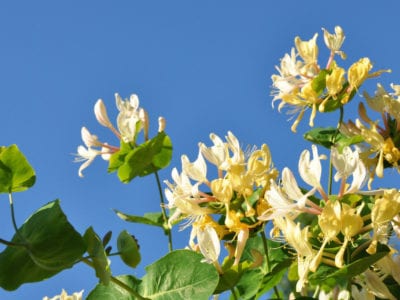Summer in the Park
It’s high summer and time to enjoy the colours and scents of the season! The long, warm evenings are the perfect time for a nature walk. As twilight falls, wild flowers produce scent to attract insects and different types of bats can been seen swooping between the trees.
One of the finest wild flowers is the honeysuckle, which grows in woodland and along hedgerows, weaving through shrubs and trees. It is common and widespread throughout the British Isles. Honeysuckle is hugely valuable to wildlife as it supports a number of rare species including the white admiral butterfly and bumblebees.
 Pollinating moths such as the Elephant Hawkmoth are attracted to the sweet scent of honeysuckle at night, when it is strongest, and birds, including thrushes and bullfinches, eat the berries when they ripen in late summer and autumn. Dormice also rely on honeysuckle for food and shelter. They use honeysuckle bark to build nests for their young and also eat the sweet, nectar-rich flowers as a source of energy.
Pollinating moths such as the Elephant Hawkmoth are attracted to the sweet scent of honeysuckle at night, when it is strongest, and birds, including thrushes and bullfinches, eat the berries when they ripen in late summer and autumn. Dormice also rely on honeysuckle for food and shelter. They use honeysuckle bark to build nests for their young and also eat the sweet, nectar-rich flowers as a source of energy.
It was once believed that if honeysuckle grew around your door, it would bring good luck and stop evil spirits from entering the house. It has also long been considered a symbol of fidelity, and in Victorian times young girls were banned from bringing honeysuckle into the house because it was believed the strong smell would make them have suggestive dreams!
Honeysuckle has also been used to make beautiful walking sticks. They were created as the honeysuckle entwined itself around branches, causing the branches themselves to become twisted. While the berries are poisonous, the leaves, flowers and seeds have been used for medicinal purposes for a variety of conditions. Look out for the delicate flowers of the honeysuckle twining around other plants as you enjoy a walk in the park; you may well notice the scent first!
With thanks to the Woodland Trust for additional information.